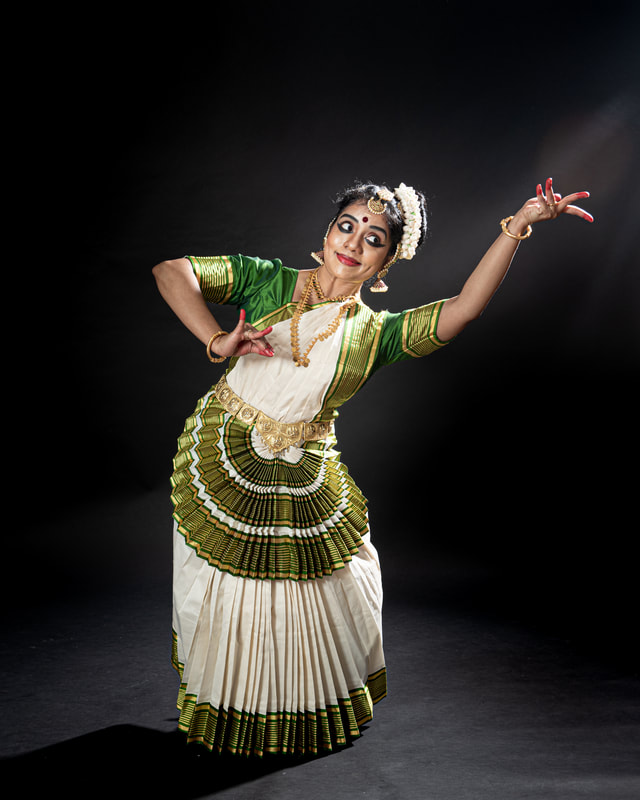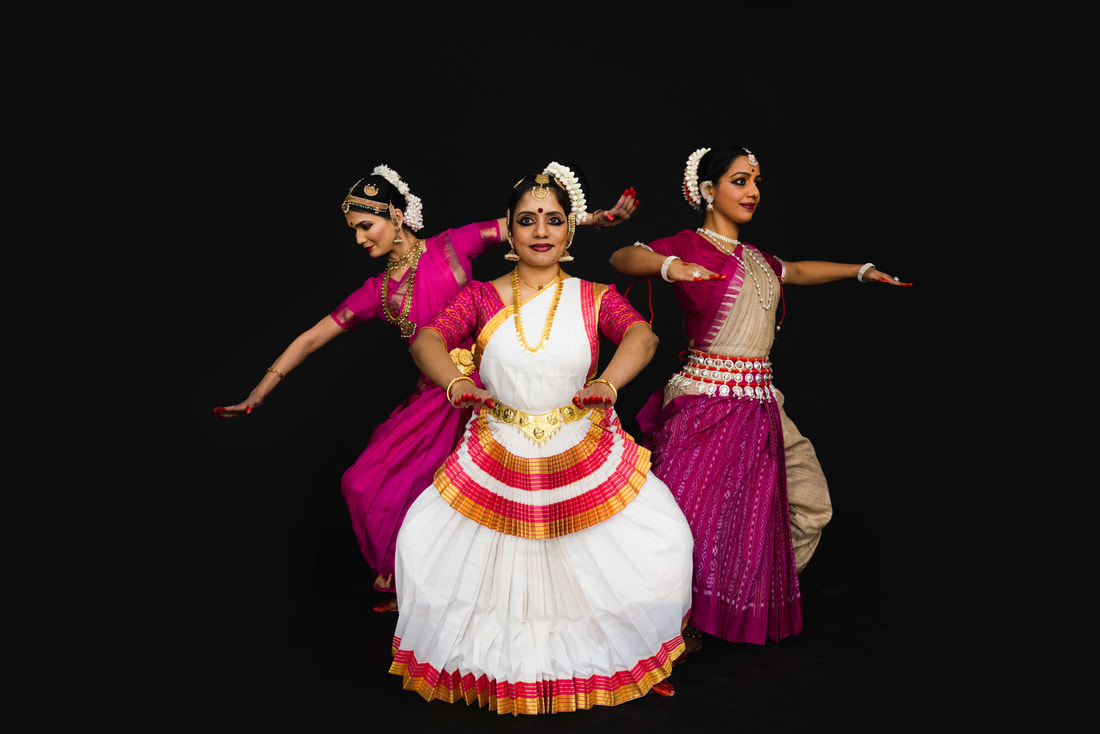|
One of the most exciting aspects of producing NACHMO Boston each year is getting to work with dancers from other styles and traditions. When we heard about Samāgata, Monkeyhouse co-Artistic Director, karen Krolak, thought it would be a great opportunity to introduce you to three outstanding classical Indian soloists that we have met through NACHMO Boston: Soumya Rajaram (Bharatanatyam), Sapna Govindan (Mohiniyattam), and Priya Bangal (Odissi). Samāgata, is an evening of classical Indian dance solos by three artists in - Mohiniyattam, Bharatanatyam and Odissi. It will be presented at Andover Town House (Old Town Hall) at 20 Main St, Andover, MA on Saturday, June 11 2022 at 7:30pm. The venue is accessible for people who use mobility devices. Tickets are free. Pre-register here to reserve seating. karen decided to interview each one of the artists for a different local dance blog. We start with Sapna here but be on the lookout for another interview with Priya on the Dance Complex's blog, and a conversation with Soumya on the CreativeGround blog. karen: Recently, I have been mentoring Alive Dance Collective whose company talks about being "full time humans, part time dancers". It has made me curious about how many dancers in our area balance performing with other seemingly unrelated jobs. You are both an Anesthesiologist and a Mohiniyattam soloist. How do those parts of you influence each other? Sapna Govindan: Full time humans, part time dancers - that is quite an interesting take. It made me think about how many different roles we juggle in our day to day lives. I have been a doctor and a dancer for a long time now. So by now it feels quite natural to be both. However, this dichotomy is not without its struggles. So maybe I should talk about the struggles first. It goes without saying that being a doctor is a very demanding and at most times a very inflexible job. Balancing that with serious dance pursuit has required me to let go of certain other things in life. I certainly do not believe that one can have it all. Even simple things like getting enough sleep to ensure one has stamina to dance can seem like a project when I have been on frequent overnight calls at the hospital. However, this has taught me to strike a balance and make use of what time is available to me smartly. I told myself that I will continue to dance no matter what when I started my medical training many years back. Dance has certainly kept me grounded throughout my medical career. It has been a home to go back to regardless of how hard the medical training got. On the other hand, being an anesthesiologist has definitely shaped my personality to stay calm, even-keeled and meet challenges head on. Also, it has built a certain sense of responsibility and professionalism towards everything I do. I believe this has translated into my dance career as well. k: You previously performed with Priya and Soumya in Transcendence as part of Jose Mateo's Dance Saturdays program. One of the things that I truly appreciated about that concert was how Janani Swamy wove the pieces together with insights about each of the different forms of classical Indian dance and music. What are you learning from performing alongside artists in different dance styles? SG: Performing as part of the Transcendence project is something I truly enjoyed. I believe that having a community of like-minded dancers is huge. This feels all the more important coming off of the isolation we went through during the pandemic. Priya, Soumya and I were already working on a project called “Samāgata: A coming together”, when Transcendence happened. The various Indian classical dance forms have many pan-Indian factors that connect them with each other such as the texts they are based on, musical styles, or the content that takes inspiration from epics and other literary works. At the same time, each of them have strong regional identities depending on which part of India they come from. To me, this kind of collaboration has provided a much needed sense of community, a kind of give and take where we encourage each other, enjoy the commonalities and at the same time learn about nuances and aspects that are unique to each style. I strongly believe that this kind of engagement with dancers of different backgrounds leads to the organic growth of an artist as ultimately art connects everyone beyond all differences. k: One of the challenges I find when I am an audience member for a style of dance that I have not previously studied is figuring out which nuances of the form have meaning. My undergraduate degree was in linguistics and the metaphor that I use in my head is finding the phoneme of this dance language. I really appreciate how your work with Soumya and Priya teaches you more about that in Bharatanatyam and Odissi. I wonder what details do you want first time audience members to notice about Mohiniyattam?
SG: All classical dance forms of India are structurally categorized into abstract dance and interpretive dance. Some dances are purely abstract in nature where body movements are combined with footwork and hand gestures to create dance that explores the melodic and rhythmic aspects of music. Others use body movements and footwork along with hand gestures with meaning and facial expressions to create interpretive dance. These elements are common across Mohiniyattam, Bharatanatyam and Odissi. The difference lies in how this is executed. Mohiniyattam, a dance form originating in the southern Indian state of Kerala, has been variously described as lyrical, sinuous and as a lasya (feminine grace) predominant form. The reason lies in the distinct curvilinear movements of the upper torso called “Andolika” or “Chuzhippu”. In its abstract form, Mohiniyattam employs a stable and grounded lower body while the upper body moves with a controlled lightness in circles, half circles and side to side swaying movements. The arms also follow a similar pattern. While the footwork responds to the rhythmic aspect, the upper body movements respond to the melodic aspect of the music. How the dancing body responds to the music is definitely something to notice while watching this form. Mohiniyattam is also known for its detailed abhinaya (dance with meaning) using specific hand gestures, and facial expressions with particular emphasis on the usage of eyes in expressing meaning. It stands close to the theatrical traditions of Kerala in this aspect. These are some details to watch out for in the performance. k: What do you admire about Priya's dancing that you would suggest that first time audience members observe? SG: Odissi is a form that I admire greatly. I might have learned it if I hadn’t fallen in love with Mohiniyattam! Odissi also employs fluid, sinuous movements of the upper torso but this is executed in a stylistically different manner than Mohiniyattam. Watch out for the soft, undulation of the upper torso isolated from the hips and shoulders (in Mohiniyattam, the upper torso generally moves as one unit) which brings out the musical quality in the dance. Odissi has also taken inspiration from the temple sculptures of Odisha, the land of its origin. This can be seen in the distinctive “Tribhangi” stance – an asymmetrical stance achieved by thrice deflecting the body into an S shaped curve which was adapted from sculptures. As with other forms, the musicality of body movements and rhythmic patterns in the footwork are to watch out for. k: I know that Mohiniyattam and Bharatanatyam are more closely related. What are some differences that audiences should notice? SG: You are right. Both Mohiniyattam and Bharatanatyam are closely related as both forms are from southern India and yet they are distinct from each other in many ways. Bharatanatyam is the first dance form I learned as a young girl as I made my first foray into dancing. This has allowed me to appreciate the similarities and differences in the movement vocabulary better. To start with the basics, the basic stance in Mohiniyattam employs a wide base with feet apart which allows for volume in the curvilinear movements of the upper torso. Bharatanatyam’s basic stance is with feet close together and the upper torso is held erect for most of the time. In Bharatanatyam, the arm movements are more angular and straight (but not always) compared to the rounded movements employed by Mohiniyattam. You will notice the dancer employing leaps and jumps in Bharatanatyam whereas Mohiniyattam is very much a grounded form. In general, you will notice brisk and fast paced movements in Bharatanatyam whereas Mohiniyattam is set to slow to medium tempo which allows for the detailed execution of its curvilinear movements. These are some of the differences you will be noticing. I think these are great questions which give us an opportunity to engage with our potential audience. In an effort to prepare our audience for the performance, we will be holding a pre-performance talk and demonstration at the Andover Center for History and Culture on June 2 at 7:00 pm. The admission is free, though RSVP is requested as seating is limited. Those interested may visit andoverhistoryandculture.org for registration. We hope efforts like these will work towards demystifying these forms and help to build an audience for them. k: As a performer from a non-western dance tradition, it must be exhausting having to educate people about your work. If people want to learn more so that you do not have to do all that extra labor on our behalf, are there books or websites that you would suggest? SG:These are complex art forms and there isn't a concise resource to learn technicalities but the way to learn about it is the way you would learn about any complex art form - watch more good dance, watch the stalwarts in the field, follow their work and don't miss a chance to watch them live. Most professional dancers introduce their work in a way friendly to the uninitiated audience, especially when performing in foreign countries. Most of them also conduct lecture-demonstrations on their tours, or have educational materials posted online. Since art and cultural ethos are so closely tied, it also helps to familiarize yourself with other cultural aspects, music, literature, mythology and other arts. There are art magazines and online resources available. It is difficult to recommend one or two but Sahapedia is a very well researched and exhaustive source. I have been a guest contributor on Sahapedia. My article "Traditions in Mohiniyattam" is available there where I have tried to put together the history and evolution of different traditions/styles within the form of Mohiniyattam from available sources. k: Thank you, that is super helpful. I am so looking forward to seeing Samāgata!
0 Comments
|
Categories
All
Archives
April 2023
|
MONKEYHOUSE


 RSS Feed
RSS Feed
